With so many variations of leafy houseplants popping up, creating your own collection could become a fascinating and healthy hobby.
Most indoor plants are from the tropical regions of South America, Asia, the Caribbean and Africa. Building a collection, and becoming a proud plant parent, brings this fascinating and cosmopolitan world of plants into your living room.
Delving into their origins not only intrigues (especially the kids) but connects us to the wider world. As for health, studies have shown that plants promote a feeling of wellbeing, reduce stress and increase productivity. They also help to purify the air within the home, with many being able to absorb harmful toxins.
And beauty? That’s a no brainer. Houseplants help to soften and transform spaces, adding living texture and colour.
Most importantly, houseplants keep us connected to nature, even high up in the sky in in a multi-story apartment building. Plant ‘pets’ need care and constantly delight us as they change and grow. Of course, you might just fall prey to a new syndrome : leaf envy.
Here are some trending foliage plants for your burgeoning collection:
Proud as a peacock
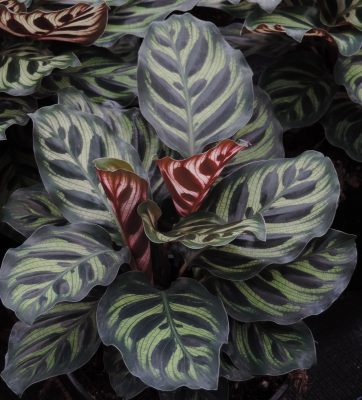 Calathea ‘Makoyana’ is known as the Peacock Plant because of its elegant leaves with bold feathery markings. The new leaves are a bright pinkish red.
Calathea ‘Makoyana’ is known as the Peacock Plant because of its elegant leaves with bold feathery markings. The new leaves are a bright pinkish red.
It hails from tropical Brazil which means that it loves humid conditions, which is easily achieved by keeping the soil consistently moist and misting the plant as often as possible. Use distilled or rainwater if your water had a high fluoride content. It does best in medium to low light which makes it easy to place in the home.
Cool customer
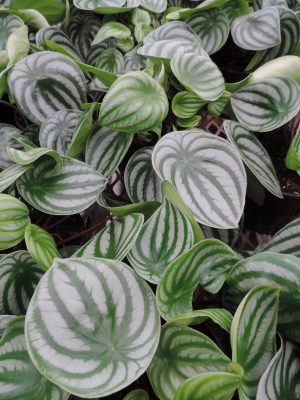 Peperomia ‘Watermelon’ has large, round fleshy leaves that look like the rind of a watermelon. This is a good plant for a beginner, being easy to care for. It just needs enough bright light and should not be over watered. The plants stay small and compact, Even when fully grown it is compact and bushy, fitting easily on a bookcase, desk-top, windowsill or wherever its unusual leaves can be appreciated.
Peperomia ‘Watermelon’ has large, round fleshy leaves that look like the rind of a watermelon. This is a good plant for a beginner, being easy to care for. It just needs enough bright light and should not be over watered. The plants stay small and compact, Even when fully grown it is compact and bushy, fitting easily on a bookcase, desk-top, windowsill or wherever its unusual leaves can be appreciated.
A rose by any other name
 The rose painted Calathea (Roseopicta) has variegated leaves with pink stripes and pink midrib which is pronounced in the younger leaves. The under-leaf is also a dark pink. The leaves fold slightly in the evening and open the next morning.
The rose painted Calathea (Roseopicta) has variegated leaves with pink stripes and pink midrib which is pronounced in the younger leaves. The under-leaf is also a dark pink. The leaves fold slightly in the evening and open the next morning.
This plant is also from Brazil, and likes a warm, humid environment. It is less demanding than other Calathea and can be kept on a warm balcony or patio in medium to bright light but no direct sunlight.
Mist the leaves to increase humidity or place the pot on small stones in a saucer that is filled with water.. A liquid feed once a month will encourage lush leaves. It is NOT toxic to pets (cats and dogs).
The friendly Dragon
 Alocasia ‘Dragon Scale’ couldn’t be better named, with its unusual metallic-green leaves and pronounced dark-green veins. A great plant for beginners, this easy to care for indoor tropical plant originates from the dappled forest floors of Borneo. It likes a warm, humid room with bright light (no sun). Make a feature of it on a coffee table, in the home office or bedroom. Allow the soil to slightly dry out between watering and feed with a diluted liquid feed once a month in summer
Alocasia ‘Dragon Scale’ couldn’t be better named, with its unusual metallic-green leaves and pronounced dark-green veins. A great plant for beginners, this easy to care for indoor tropical plant originates from the dappled forest floors of Borneo. It likes a warm, humid room with bright light (no sun). Make a feature of it on a coffee table, in the home office or bedroom. Allow the soil to slightly dry out between watering and feed with a diluted liquid feed once a month in summer
A jewel of a plant
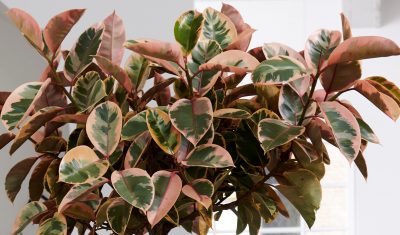 Ficus elastica ‘Ruby’ has an unusual tri-colour variegation of its leaves and needs bright indirect light (but not sun) to maintain their brilliant colour. It originates from the tropical areas of India and Malaysia. The reason it needs plenty of light it because the paler pink and cream parts cannot photosynthesize so it needs plenty of bright light. It likes lightly moist soil that should not become soggy. Weekly watering should be sufficient in summer. Avoid over watering as this can kill the plant.
Ficus elastica ‘Ruby’ has an unusual tri-colour variegation of its leaves and needs bright indirect light (but not sun) to maintain their brilliant colour. It originates from the tropical areas of India and Malaysia. The reason it needs plenty of light it because the paler pink and cream parts cannot photosynthesize so it needs plenty of bright light. It likes lightly moist soil that should not become soggy. Weekly watering should be sufficient in summer. Avoid over watering as this can kill the plant.
Rotate the plant periodically to ensure even growth on all sides and wipe the leaves to remove dust.
Pint-sized charmer
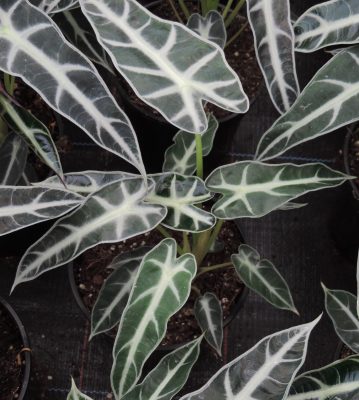 Alocasia bambino is a miniature version of the larger Amazonica. It also has the striking, shield -shaped dark leaves with sliver veins, but only grows 30cm high, and stays compact. It’s a petite feature plant that doesn’t need a lot of space, a good desktop companion for the home office.
Alocasia bambino is a miniature version of the larger Amazonica. It also has the striking, shield -shaped dark leaves with sliver veins, but only grows 30cm high, and stays compact. It’s a petite feature plant that doesn’t need a lot of space, a good desktop companion for the home office.
Let the soil almost dry out before watering. If the plant develops spider mites it could mean that the plant requires more humidity. Spray with a dilution of Neem oil and move to a more humid space or closer to the humidifier.
Cutting edge
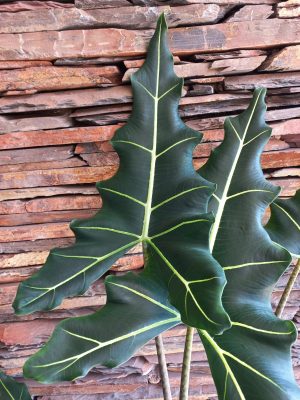 Alocasia sarian is a variation of the elephant ear and it can grow into a large plant with spectacular pointed leaves. It is easy to care for, likes bright light or filtered sunlight and should not be dry out completely or be over watered. Allow the top third of the soil to dry out before watering. A humidity tray with pebbles should meet its humidity requirements. Fertilise with a liquid plant food once a month in summer. Hose off the leaves every now and then to get rid of dust. This plant is a hybrid cross with Alocasia zebrina and is named after Zac B. Sarian who is an agricultural journalist in The Philippines.
Alocasia sarian is a variation of the elephant ear and it can grow into a large plant with spectacular pointed leaves. It is easy to care for, likes bright light or filtered sunlight and should not be dry out completely or be over watered. Allow the top third of the soil to dry out before watering. A humidity tray with pebbles should meet its humidity requirements. Fertilise with a liquid plant food once a month in summer. Hose off the leaves every now and then to get rid of dust. This plant is a hybrid cross with Alocasia zebrina and is named after Zac B. Sarian who is an agricultural journalist in The Philippines.
Text: Alice Coetzee


